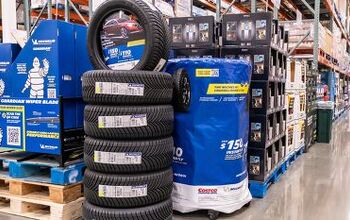Junkyard Find: 2001 Jeep Cherokee Classic 4x4

The XJ Cherokee was born out of the French government's bailout of American Motors and made its debut as a 1984 model. It was so successful that it stayed in production in essentially its original form through three corporations and into the following century. Today's Junkyard Find is one of the very last XJ Cherokees ever made, found in a Wyoming car graveyard last week.
Along with the Renault technology that made the design and production of the Alliance, Encore, and Eagle Premier possible, American Motors also got François Castaing, the brilliant Renault engineer who became the mastermind behind the XJ Cherokee.
The result was a unibody truck that weighed 1,200 fewer pounds than its body-on-frame SJ Cherokee predecessor, a hulking military-style brute, while providing nearly as much interior space.
The XJ looked like a tough truck, suitable for hairy-chested outdoorsmen, but it drove more like a car and got impressive gas mileage as part of the bargain. It may not have been quite as good for extreme off-road use as the SJ, but it handled real-world snow and mud competently.
The XJ Cherokee put the hammer down on the truckification of the American road; the 1991 Ford Explorer and 1993 Jeep Grand Cherokee finished the cultural shift that brought us to where we are today.
The Grand Cherokee was supposed to be the XJ Cherokee's replacement, but buyers kept driving XJs out of Jeep showrooms and so Chrysler and, later, DaimlerChrysler kept building them.
2001 was the final model year for the XJ Cherokee in the New World, making this truck of the very last examples sold here. In China, however, XJ production continued all the way through 2014 (and maybe later).
The XJ Cherokee came with an impressive variety of engines during its long production run, including the often-mistaken-for-an- Iron-Duke AMC 2.5-liter four-cylinder, a couple of diesels, and even the 2.8-liter GM 60° V6.
Most XJs got a 4.0-liter version of the good old AMC straight-six, a sturdy pushrod engine dating back to the 1960s, and that's what's in this truck. The rust stains in the engine compartment suggest a catastrophic overheating event, maybe a blown head gasket.
The 4.0 in this truck was rated at 190 horsepower and 225 pound-feet.
Plenty of rear-wheel-drive XJs were sold, but this one has the most common configuration: four-wheel-drive, automatic transmission, 4.0 engine.
The electronic odometer means I couldn't learn the final mileage. I've found some discarded XJs with very high final odometer readings, though most I see traversed between 150,000 and 200,000 miles during their lives.
The body and interior looked pretty decent, even after a life in the rough climates of Colorado and Wyoming. Some costly mechanical failure likely doomed this truck.
There's something of an XJ Cherokee glut in this region, so these trucks aren't worth quite as much here as they would be in the Midwest or West Coast. Still, I'm a bit surprised by the number of nice examples still showing up in Front Range boneyards.
Climbs a 30 percent grade, laughs at an 80 percent chance of snow, gives you 100 percent freedom.

Murilee Martin is the pen name of Phil Greden, a writer who has lived in Minnesota, California, Georgia and (now) Colorado. He has toiled at copywriting, technical writing, junkmail writing, fiction writing and now automotive writing. He has owned many terrible vehicles and some good ones. He spends a great deal of time in self-service junkyards. These days, he writes for publications including Autoweek, Autoblog, Hagerty, The Truth About Cars and Capital One.
More by Murilee Martin
Latest Car Reviews
Read moreLatest Product Reviews
Read moreRecent Comments
- Theflyersfan Keep the car. It's reliable, hasn't nickeled and dimed you to death, and it looks like you're a homeowner so something with a back seat and a trunk is really helpful! As I've discovered becoming a homeowner with a car with no back seat and a trunk the size of a large cooler, even simple Target or Ikea runs get complicated if you don't ride up with a friend with a larger car. And I wonder if the old VW has now been left in Price Hill with the keys in the ignition and a "Please take me" sign taped to the windshield? The problems it had weren't going to improve with time.
- SPPPP I don't think it's a sign of pressure from external competition, but rather a healthy sign of letting practicality trump triumphalism on the assembly floor. Does a 1-piece casting make sense? Imagine the huge investment (no pun intended) in the tooling for that structure. Now imagine that a change in regulation or market conditions requires a change to the structure. You're going to build all the tooling all over again? Why not use "gigacasting" selectively, to build right-sized modules that can be assembled simply and repeatably? Changing 1/3 of the tooling is much less costly. Additionally, it makes the vehicles repairable, instead of being subject to total loss in a minor accident.
- Formula m Oh my first Ford learning experience was with a sales manager who is a former stripclub manager with a Satan’s choice tattoo on his forearm… was very eye opening. You can imagine how he has contributed to Ottawa over his long tenure with Ford. Hopefully A.I. gives a different experience
- Slavuta This video explains the whole situation and also goes back when Musk was laughing off chinese companies
- SPPPP Nice vehicle. My only fear with driving it so little is rodent damage - but I guess keeping it in the garage cuts that risk down a lot.














































Comments
Join the conversation
By far the most popular vehicle in my High School’s parking lot, circa 2006. Could really haul a lot of gear.
Carson D,
Re Your friend's Cherokee with mysterious engine management issues:
If still applicable, have him swap out the Crankshaft, Camshaft, and Throttle Body Position Sensors with new good OEM parts (no after-market). AND check the +5v VSen power supply coming out of the ECU, to make sure that supply is clean and stable.
Had a lot of 'fun' chasing that one down on my own Cherokee.